 = 0.833)
= 0.833) = 0.833)
= 0.833)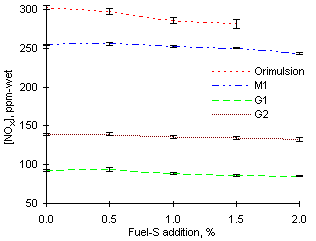
 = 0.833
= 0.833All fuels investigated showed a net decrease of NOX emissions when sulphur was added as SO2-gas. The experimental readings are shown in Figure 134.
In the absence of sulphur addition, Orimulsion yielded the largest NOX emissions, followed by fuels M1, G2 and G1.
Orimulsion also had the largest nominal reduction of NOX emissions among all fuels studied, from 302.7 ppm-wet in air to 281.5 ppm-wet with 1.5 % sulphur added (approximately 5 % of the initial NOX emissions per 1 % fuel-S added). It is expected that a larger addition of sulphur would cause a further reduction of NOX emissions.
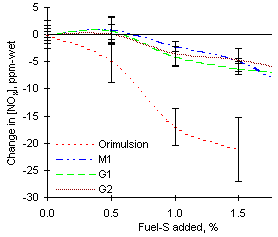
 = 0.833 from all fuels investigated
= 0.833 from all fuels investigatedSmaller reductions of NOX emissions were achieved from the other fuels studied, the heavy coker and vacuum gas oils M1, G1 and G2. In general, nominal values of the decrease of NOX concentrations were similar for these fuels, regardless their initial nitrogen and sulphur content. Thus, after almost no change at 0.5 % of S addition, the readings of NOX were decreased almost uniformly by 7 to 11 ppm-wet with addition of 2 % fuel-S, which can be seen in Figure 135.
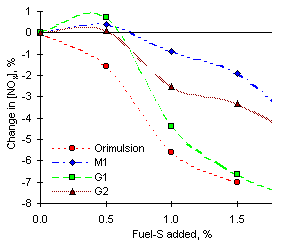
 = 0.833 from all fuels investigated
= 0.833 from all fuels investigatedThe percentage change of NOX emissions can be seen in Figure 136. Reductions of NOX emissions are obtained at almost all additions of sulphur investigated. However, no correlation could be established between the percentage of sulphur added and the reduction of NOX concentrations obtained. The percentage change is larger for Orimulsion (N content = 0.40 %) and fuel G1 (N content = 0.13 %).
 = 1.000)
= 1.000)In the absence of sulphur addition, the largest emissions of NOX corresponded to fuel M1 (97.7 ppm-wet), which also has the largest fuel-N content (0.32 %) among these fuels. Both heavy vacuum gas oils G1 and G2 caused lower emissions of NOX (91.1 and 80.3 ppm-wet, respectively).
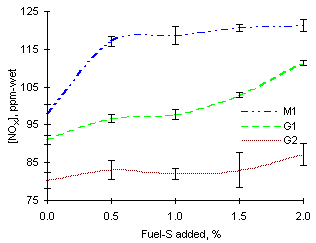
 = 1.000
= 1.000The effect of the addition of sulphur on oxides of nitrogen at stoichiometric conditions is that of increasing emissions from all fuels investigated. This effect can be observed in Figure 137 and 138.
The increase of NOX emissions is largest for fuel M1, although it seems to stabilise after the initial increase of 0.5 % fuel-S. The maximum increase was 23.6 ppm-wet (24.2 % of the initial SO2 emissions) obtained on addition of 2 % fuel-S.
Moderate increases of NOX were obtained from fuels G1 and G2. These were approximately 10 ppm-wet per 1 % fuel-S added for fuel G1 and 3.5 ppm-wet per 1 % fuel-S added to fuel G2.
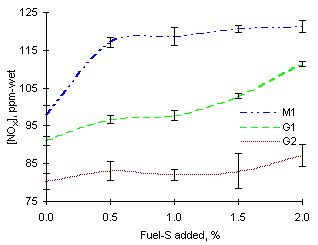
 = 1.000 from the fuels investigated
= 1.000 from the fuels investigated
It is worth mentioning the change of the relative amounts of NO and NO2 found at stoichiometric conditions. Unlike at other equivalence ratios, significant amounts of both NO and NO2 are formed at  = 1.000. However, the percentages of NO and NO2 vary as increasing amounts of fuel-S are added to the combustion environment. Emissions of NO decrease as those of NO2 increase. Figure 139 shows a graph of the [NO]/[NO2] ratio vs percentage of fuel-S addition.
= 1.000. However, the percentages of NO and NO2 vary as increasing amounts of fuel-S are added to the combustion environment. Emissions of NO decrease as those of NO2 increase. Figure 139 shows a graph of the [NO]/[NO2] ratio vs percentage of fuel-S addition.
The [NO]/[NO2] ratios was similar for fuels M1 and G2, ranging between 1.7 in air and 0.9 with addition of 2 % S. Fuel G1 showed much lower ratios, between 0.3 and 0.1, denoting larger amounts of NO2 than those of NO at all sulphur additions investigated.
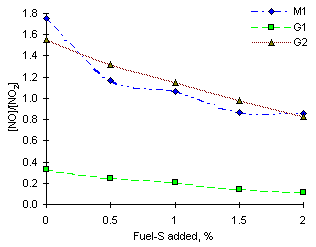
 = 1.000
= 1.000
 = 1.200)
= 1.200)
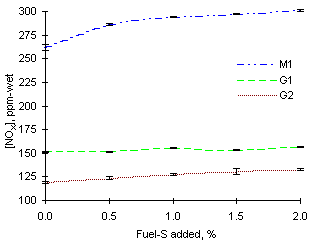
 = 1.200
= 1.200Emissions of NOX were highest from fuel M1 (262 ppm-wet in combustion in air), whereas they were intermediate from fuel G1 (151 ppm-wet) and lowest from fuel G2 (119.1 ppm-wet).
Calculations of the percentage increase of NOX emissions when SO2 was added to the combustion system yielded the results shown in Figure 141. This graph shows that maximum increases of NOX emissions were presented by fuel M1, whose emissions increased by 15 % (39 ppm-wet) with addition of 2 % fuel-S. Intermediate increases of NOX emissions were obtained from fuel G2 (11.4 %, ie 13.6 ppm-wet), whereas the lowest increases were obtained from fuel G1 (3.5 %, ie 5.4 ppm-wet).
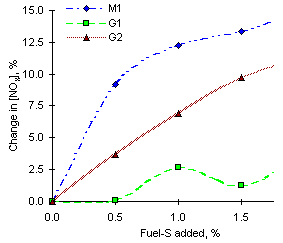
 = 1.200 from experiments of sulphur addition from the fuels investigated
= 1.200 from experiments of sulphur addition from the fuels investigated
 Previous |  Table of Contents |  Next |